DETERIORATING PATIENT: Clinical Reasoning Cycle and Nursing Interventions for Osteoarthritis and Diabetic Neuropathy
VerifiedAdded on 2023/04/24
|11
|3124
|235
AI Summary
This article discusses the clinical reasoning cycle and nursing interventions for osteoarthritis and diabetic neuropathy in the case of Mary Smith, an 82-year-old patient. It covers cues collection, problem identification, goal establishment, action implementation, and evaluation. It also suggests nursing interventions such as aquatic exercise, managing risk factors, non-steroidal anti-inflammatory drugs, Tai Chi, aromatherapy, antidepressants, and acupuncture.
Contribute Materials
Your contribution can guide someone’s learning journey. Share your
documents today.
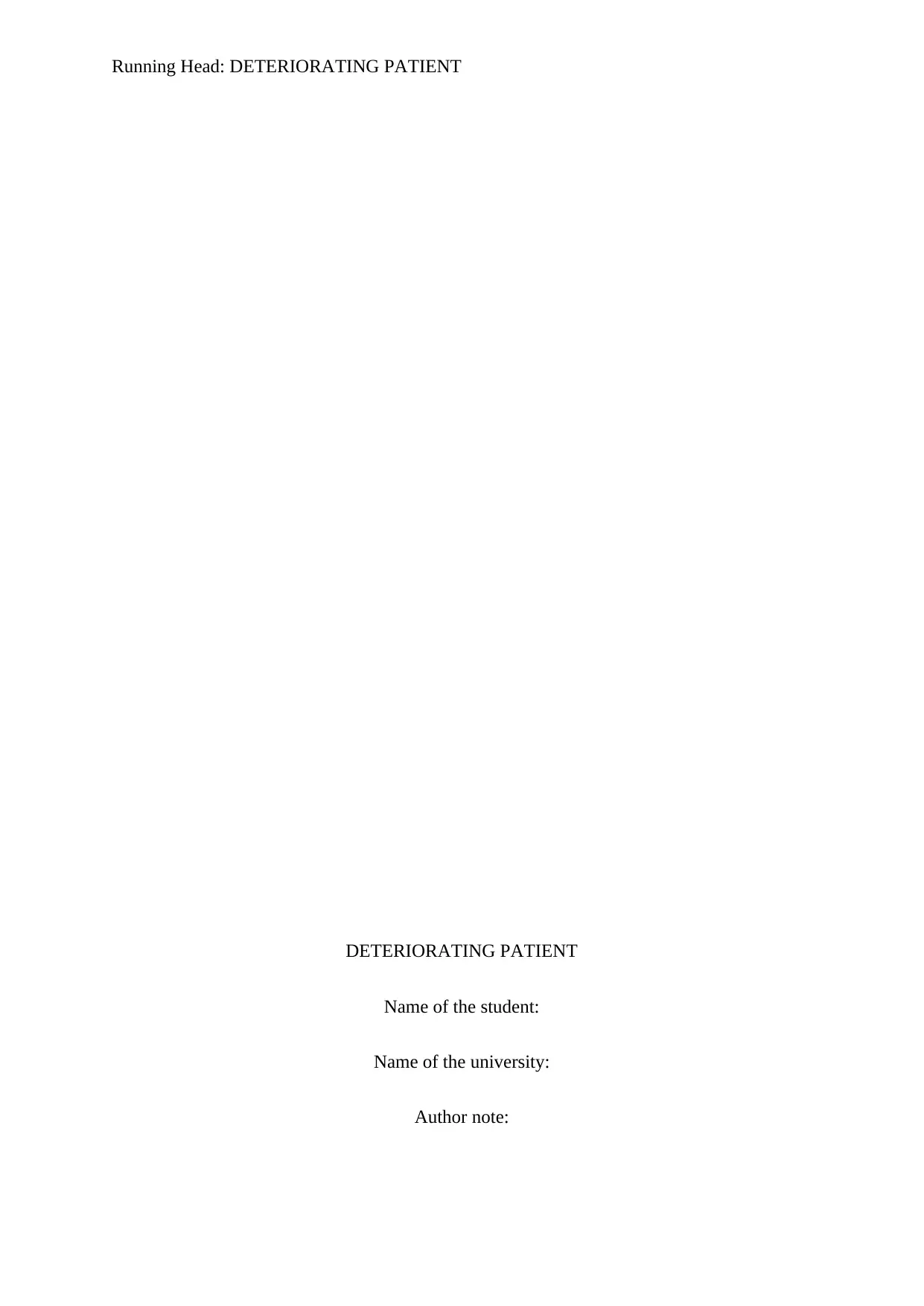
Running Head: DETERIORATING PATIENT
DETERIORATING PATIENT
Name of the student:
Name of the university:
Author note:
DETERIORATING PATIENT
Name of the student:
Name of the university:
Author note:
Secure Best Marks with AI Grader
Need help grading? Try our AI Grader for instant feedback on your assignments.
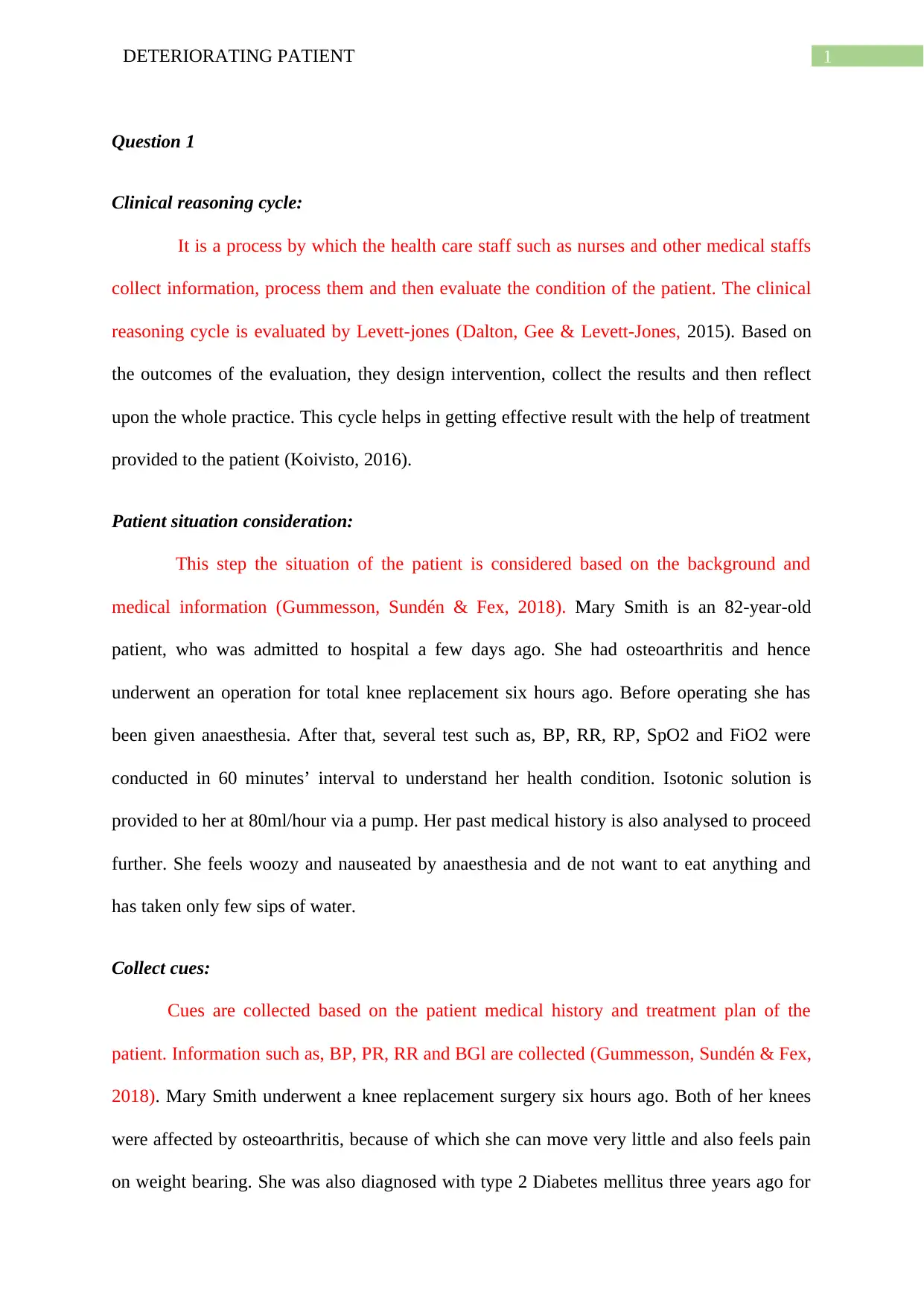
1DETERIORATING PATIENT
Question 1
Clinical reasoning cycle:
It is a process by which the health care staff such as nurses and other medical staffs
collect information, process them and then evaluate the condition of the patient. The clinical
reasoning cycle is evaluated by Levett-jones (Dalton, Gee & Levett-Jones, 2015). Based on
the outcomes of the evaluation, they design intervention, collect the results and then reflect
upon the whole practice. This cycle helps in getting effective result with the help of treatment
provided to the patient (Koivisto, 2016).
Patient situation consideration:
This step the situation of the patient is considered based on the background and
medical information (Gummesson, Sundén & Fex, 2018). Mary Smith is an 82-year-old
patient, who was admitted to hospital a few days ago. She had osteoarthritis and hence
underwent an operation for total knee replacement six hours ago. Before operating she has
been given anaesthesia. After that, several test such as, BP, RR, RP, SpO2 and FiO2 were
conducted in 60 minutes’ interval to understand her health condition. Isotonic solution is
provided to her at 80ml/hour via a pump. Her past medical history is also analysed to proceed
further. She feels woozy and nauseated by anaesthesia and de not want to eat anything and
has taken only few sips of water.
Collect cues:
Cues are collected based on the patient medical history and treatment plan of the
patient. Information such as, BP, PR, RR and BGl are collected (Gummesson, Sundén & Fex,
2018). Mary Smith underwent a knee replacement surgery six hours ago. Both of her knees
were affected by osteoarthritis, because of which she can move very little and also feels pain
on weight bearing. She was also diagnosed with type 2 Diabetes mellitus three years ago for
Question 1
Clinical reasoning cycle:
It is a process by which the health care staff such as nurses and other medical staffs
collect information, process them and then evaluate the condition of the patient. The clinical
reasoning cycle is evaluated by Levett-jones (Dalton, Gee & Levett-Jones, 2015). Based on
the outcomes of the evaluation, they design intervention, collect the results and then reflect
upon the whole practice. This cycle helps in getting effective result with the help of treatment
provided to the patient (Koivisto, 2016).
Patient situation consideration:
This step the situation of the patient is considered based on the background and
medical information (Gummesson, Sundén & Fex, 2018). Mary Smith is an 82-year-old
patient, who was admitted to hospital a few days ago. She had osteoarthritis and hence
underwent an operation for total knee replacement six hours ago. Before operating she has
been given anaesthesia. After that, several test such as, BP, RR, RP, SpO2 and FiO2 were
conducted in 60 minutes’ interval to understand her health condition. Isotonic solution is
provided to her at 80ml/hour via a pump. Her past medical history is also analysed to proceed
further. She feels woozy and nauseated by anaesthesia and de not want to eat anything and
has taken only few sips of water.
Collect cues:
Cues are collected based on the patient medical history and treatment plan of the
patient. Information such as, BP, PR, RR and BGl are collected (Gummesson, Sundén & Fex,
2018). Mary Smith underwent a knee replacement surgery six hours ago. Both of her knees
were affected by osteoarthritis, because of which she can move very little and also feels pain
on weight bearing. She was also diagnosed with type 2 Diabetes mellitus three years ago for
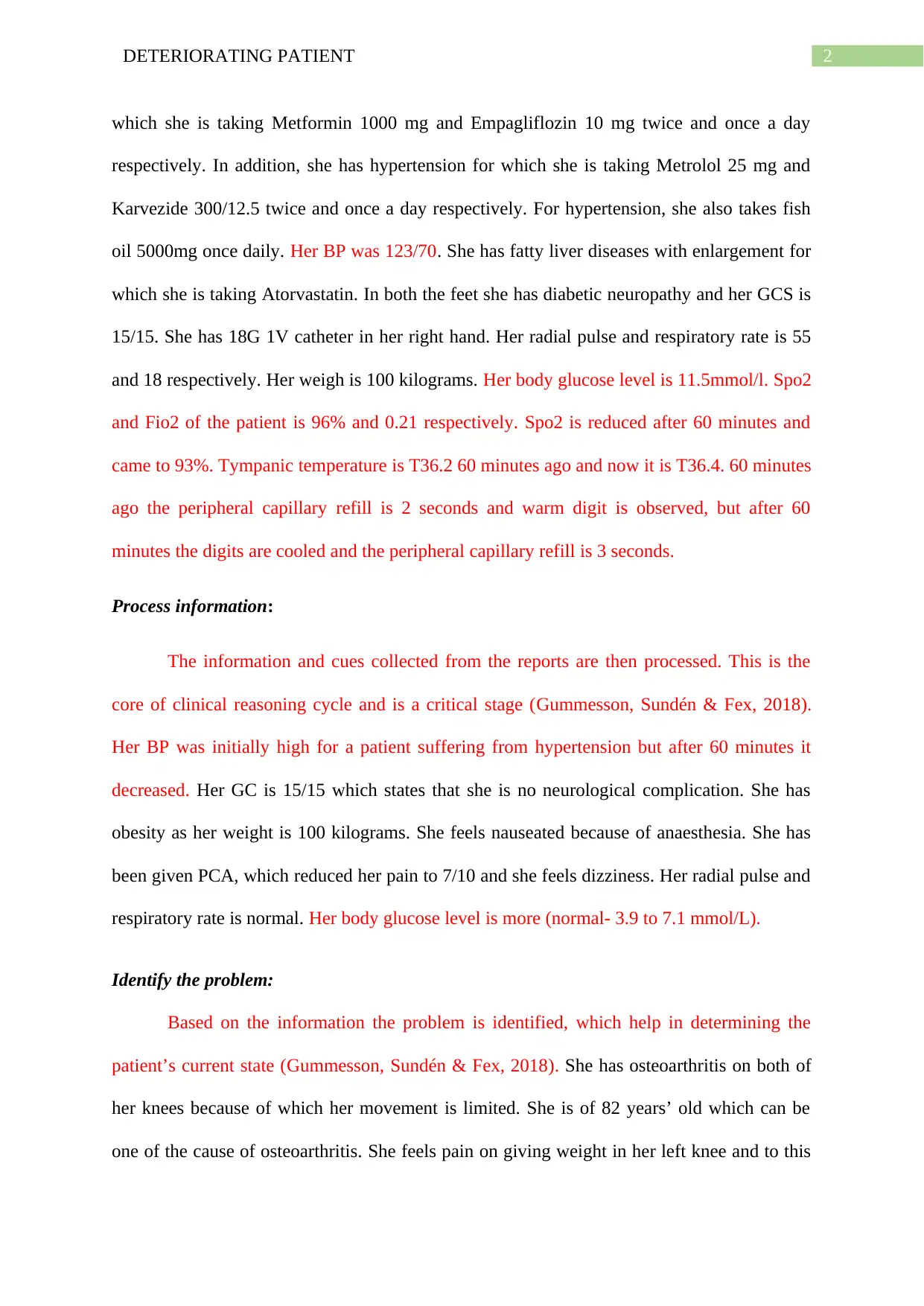
2DETERIORATING PATIENT
which she is taking Metformin 1000 mg and Empagliflozin 10 mg twice and once a day
respectively. In addition, she has hypertension for which she is taking Metrolol 25 mg and
Karvezide 300/12.5 twice and once a day respectively. For hypertension, she also takes fish
oil 5000mg once daily. Her BP was 123/70. She has fatty liver diseases with enlargement for
which she is taking Atorvastatin. In both the feet she has diabetic neuropathy and her GCS is
15/15. She has 18G 1V catheter in her right hand. Her radial pulse and respiratory rate is 55
and 18 respectively. Her weigh is 100 kilograms. Her body glucose level is 11.5mmol/l. Spo2
and Fio2 of the patient is 96% and 0.21 respectively. Spo2 is reduced after 60 minutes and
came to 93%. Tympanic temperature is T36.2 60 minutes ago and now it is T36.4. 60 minutes
ago the peripheral capillary refill is 2 seconds and warm digit is observed, but after 60
minutes the digits are cooled and the peripheral capillary refill is 3 seconds.
Process information:
The information and cues collected from the reports are then processed. This is the
core of clinical reasoning cycle and is a critical stage (Gummesson, Sundén & Fex, 2018).
Her BP was initially high for a patient suffering from hypertension but after 60 minutes it
decreased. Her GC is 15/15 which states that she is no neurological complication. She has
obesity as her weight is 100 kilograms. She feels nauseated because of anaesthesia. She has
been given PCA, which reduced her pain to 7/10 and she feels dizziness. Her radial pulse and
respiratory rate is normal. Her body glucose level is more (normal- 3.9 to 7.1 mmol/L).
Identify the problem:
Based on the information the problem is identified, which help in determining the
patient’s current state (Gummesson, Sundén & Fex, 2018). She has osteoarthritis on both of
her knees because of which her movement is limited. She is of 82 years’ old which can be
one of the cause of osteoarthritis. She feels pain on giving weight in her left knee and to this
which she is taking Metformin 1000 mg and Empagliflozin 10 mg twice and once a day
respectively. In addition, she has hypertension for which she is taking Metrolol 25 mg and
Karvezide 300/12.5 twice and once a day respectively. For hypertension, she also takes fish
oil 5000mg once daily. Her BP was 123/70. She has fatty liver diseases with enlargement for
which she is taking Atorvastatin. In both the feet she has diabetic neuropathy and her GCS is
15/15. She has 18G 1V catheter in her right hand. Her radial pulse and respiratory rate is 55
and 18 respectively. Her weigh is 100 kilograms. Her body glucose level is 11.5mmol/l. Spo2
and Fio2 of the patient is 96% and 0.21 respectively. Spo2 is reduced after 60 minutes and
came to 93%. Tympanic temperature is T36.2 60 minutes ago and now it is T36.4. 60 minutes
ago the peripheral capillary refill is 2 seconds and warm digit is observed, but after 60
minutes the digits are cooled and the peripheral capillary refill is 3 seconds.
Process information:
The information and cues collected from the reports are then processed. This is the
core of clinical reasoning cycle and is a critical stage (Gummesson, Sundén & Fex, 2018).
Her BP was initially high for a patient suffering from hypertension but after 60 minutes it
decreased. Her GC is 15/15 which states that she is no neurological complication. She has
obesity as her weight is 100 kilograms. She feels nauseated because of anaesthesia. She has
been given PCA, which reduced her pain to 7/10 and she feels dizziness. Her radial pulse and
respiratory rate is normal. Her body glucose level is more (normal- 3.9 to 7.1 mmol/L).
Identify the problem:
Based on the information the problem is identified, which help in determining the
patient’s current state (Gummesson, Sundén & Fex, 2018). She has osteoarthritis on both of
her knees because of which her movement is limited. She is of 82 years’ old which can be
one of the cause of osteoarthritis. She feels pain on giving weight in her left knee and to this

3DETERIORATING PATIENT
she has underwent total knee replacement of her left knee. She has diabetes and also
overweighed, which is considered as one of the risk factor for her diabetic neuropathy and
osteoarthritis (Tsonga, 2016).
Establish goals:
After identifying the problem the goals are established to treat the disease. Treatment
goals are developed (Gummesson, Sundén & Fex, 2018). She had osteoarthritis which was
treated by total knee replacement surgery, but along with that she has other health
complication also which needs urgent care. She has type 2 diabetes which should be treated
properly, otherwise it can worsen the symptoms of diabetic neuropathy. Her weight and
blood pressure should be reduced. Her knee pain also should be minimised (Tsonga, 2016).
Take action:
Implement action are taken. Action plan is developed based on the issue of the patient
with the help of physician and registered nurses (Gummesson, Sundén & Fex, 2018). Her
pain should be reduced by providing medication and exercise. She is also overweighed which
should be reduced by suggesting specific diet and exercise. She has hypertension which can
be reduced by medication such as beta blockers and calcium blockers and by changing the
life style. Her pain should be reduced by administrating epidurals (Maniquis-Smigel, 2017).
To treat type 2 diabetes also healthy diet, exercise and loss of weight is necessary (Lirk,
2014).. Her catheter dose should be increased if needed to reduce the pain.
Evaluate:
The effectiveness of action a plan is evaluated in this step. It allows to determine
whether the action plan is effective or not (Gummesson, Sundén & Fex, 2018). BP, pulse rate
and respiratory rate is normal for now, but we have to keep an eye on it to proceed further.
Her pain is also reduced from before. She did not feel like eating anything and feels woozy.
she has underwent total knee replacement of her left knee. She has diabetes and also
overweighed, which is considered as one of the risk factor for her diabetic neuropathy and
osteoarthritis (Tsonga, 2016).
Establish goals:
After identifying the problem the goals are established to treat the disease. Treatment
goals are developed (Gummesson, Sundén & Fex, 2018). She had osteoarthritis which was
treated by total knee replacement surgery, but along with that she has other health
complication also which needs urgent care. She has type 2 diabetes which should be treated
properly, otherwise it can worsen the symptoms of diabetic neuropathy. Her weight and
blood pressure should be reduced. Her knee pain also should be minimised (Tsonga, 2016).
Take action:
Implement action are taken. Action plan is developed based on the issue of the patient
with the help of physician and registered nurses (Gummesson, Sundén & Fex, 2018). Her
pain should be reduced by providing medication and exercise. She is also overweighed which
should be reduced by suggesting specific diet and exercise. She has hypertension which can
be reduced by medication such as beta blockers and calcium blockers and by changing the
life style. Her pain should be reduced by administrating epidurals (Maniquis-Smigel, 2017).
To treat type 2 diabetes also healthy diet, exercise and loss of weight is necessary (Lirk,
2014).. Her catheter dose should be increased if needed to reduce the pain.
Evaluate:
The effectiveness of action a plan is evaluated in this step. It allows to determine
whether the action plan is effective or not (Gummesson, Sundén & Fex, 2018). BP, pulse rate
and respiratory rate is normal for now, but we have to keep an eye on it to proceed further.
Her pain is also reduced from before. She did not feel like eating anything and feels woozy.
Secure Best Marks with AI Grader
Need help grading? Try our AI Grader for instant feedback on your assignments.
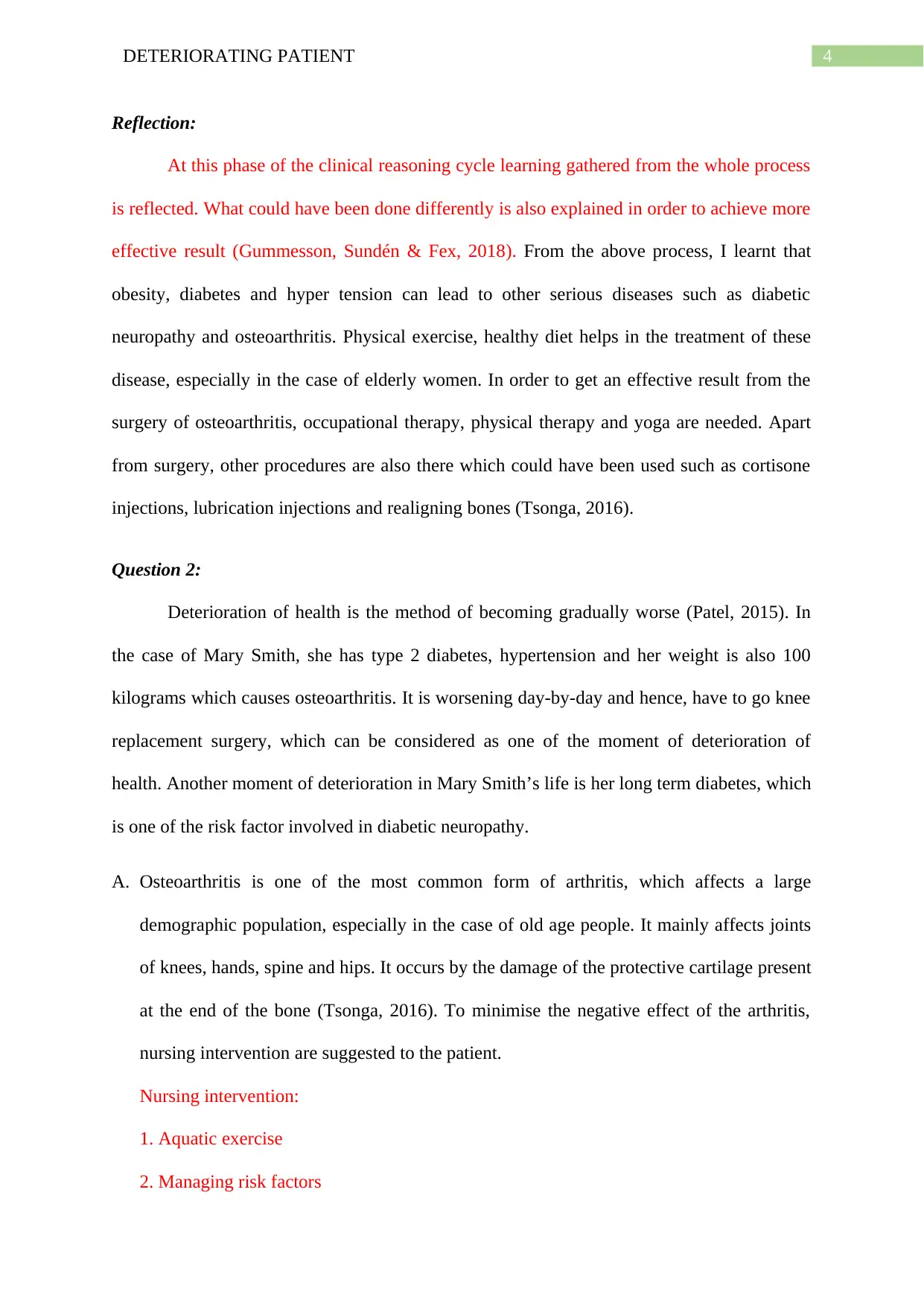
4DETERIORATING PATIENT
Reflection:
At this phase of the clinical reasoning cycle learning gathered from the whole process
is reflected. What could have been done differently is also explained in order to achieve more
effective result (Gummesson, Sundén & Fex, 2018). From the above process, I learnt that
obesity, diabetes and hyper tension can lead to other serious diseases such as diabetic
neuropathy and osteoarthritis. Physical exercise, healthy diet helps in the treatment of these
disease, especially in the case of elderly women. In order to get an effective result from the
surgery of osteoarthritis, occupational therapy, physical therapy and yoga are needed. Apart
from surgery, other procedures are also there which could have been used such as cortisone
injections, lubrication injections and realigning bones (Tsonga, 2016).
Question 2:
Deterioration of health is the method of becoming gradually worse (Patel, 2015). In
the case of Mary Smith, she has type 2 diabetes, hypertension and her weight is also 100
kilograms which causes osteoarthritis. It is worsening day-by-day and hence, have to go knee
replacement surgery, which can be considered as one of the moment of deterioration of
health. Another moment of deterioration in Mary Smith’s life is her long term diabetes, which
is one of the risk factor involved in diabetic neuropathy.
A. Osteoarthritis is one of the most common form of arthritis, which affects a large
demographic population, especially in the case of old age people. It mainly affects joints
of knees, hands, spine and hips. It occurs by the damage of the protective cartilage present
at the end of the bone (Tsonga, 2016). To minimise the negative effect of the arthritis,
nursing intervention are suggested to the patient.
Nursing intervention:
1. Aquatic exercise
2. Managing risk factors
Reflection:
At this phase of the clinical reasoning cycle learning gathered from the whole process
is reflected. What could have been done differently is also explained in order to achieve more
effective result (Gummesson, Sundén & Fex, 2018). From the above process, I learnt that
obesity, diabetes and hyper tension can lead to other serious diseases such as diabetic
neuropathy and osteoarthritis. Physical exercise, healthy diet helps in the treatment of these
disease, especially in the case of elderly women. In order to get an effective result from the
surgery of osteoarthritis, occupational therapy, physical therapy and yoga are needed. Apart
from surgery, other procedures are also there which could have been used such as cortisone
injections, lubrication injections and realigning bones (Tsonga, 2016).
Question 2:
Deterioration of health is the method of becoming gradually worse (Patel, 2015). In
the case of Mary Smith, she has type 2 diabetes, hypertension and her weight is also 100
kilograms which causes osteoarthritis. It is worsening day-by-day and hence, have to go knee
replacement surgery, which can be considered as one of the moment of deterioration of
health. Another moment of deterioration in Mary Smith’s life is her long term diabetes, which
is one of the risk factor involved in diabetic neuropathy.
A. Osteoarthritis is one of the most common form of arthritis, which affects a large
demographic population, especially in the case of old age people. It mainly affects joints
of knees, hands, spine and hips. It occurs by the damage of the protective cartilage present
at the end of the bone (Tsonga, 2016). To minimise the negative effect of the arthritis,
nursing intervention are suggested to the patient.
Nursing intervention:
1. Aquatic exercise
2. Managing risk factors

5DETERIORATING PATIENT
3. Non-steroidal anti-inflammatory drugs
4. Tai Chi
Slippery slope helps in managing the patient deterioration by providing nursing
intervention. According to slippery slope, if the intervention is provided in the initial
time, the deterioration of the patient health is minimised (Clinical Excellence
Commission, 2019). Hence in case of osteoarthritis, managing risk factors responsible for
the disease helps in preventing the disease, whereas aquatic exercise and Tai Chi can be
applied after clinical review. NSAIDs can be used as a rapid response and if the
deterioration is at the last stage, advanced life support is needed such as joint replacement
surgery (Tsonga, 2016).
1. According to Bartels (2016), physical exercise such as, aquatic exercise is used to
treat osteoarthritis in elderly patient. Aquatic exercise is an activity that takes of the
pressure of muscles and joints. It is proved to be effective in the treatment of
osteoarthritis, especially in the case of old age people. In case of Mary Smith, aquatic
exercise like swimming is suggested.
2. Osteoarthritis can be caused due to many reason. Risk factor involved in the case of
osteoarthritis is age, weight, diabetes and hypertension. Identifying these risk factor
and preventing them also helps in the treatment of disease (Glyn-Jones, 2015). In case
of Mary Smith, she is 82 years old and has type 2 diabetes, hypertension and also
overweighed, hence the effect of risk factor is minimised by using healthy diet and
exercise.
3. Non-steroidal anti-inflammatory drugs and pain relief medication are also used in the
treatment of osteoarthritis. These are the most common types of drug used in the
treatment of inflammation and any pain related disease. NSAIDs are naproxen,
3. Non-steroidal anti-inflammatory drugs
4. Tai Chi
Slippery slope helps in managing the patient deterioration by providing nursing
intervention. According to slippery slope, if the intervention is provided in the initial
time, the deterioration of the patient health is minimised (Clinical Excellence
Commission, 2019). Hence in case of osteoarthritis, managing risk factors responsible for
the disease helps in preventing the disease, whereas aquatic exercise and Tai Chi can be
applied after clinical review. NSAIDs can be used as a rapid response and if the
deterioration is at the last stage, advanced life support is needed such as joint replacement
surgery (Tsonga, 2016).
1. According to Bartels (2016), physical exercise such as, aquatic exercise is used to
treat osteoarthritis in elderly patient. Aquatic exercise is an activity that takes of the
pressure of muscles and joints. It is proved to be effective in the treatment of
osteoarthritis, especially in the case of old age people. In case of Mary Smith, aquatic
exercise like swimming is suggested.
2. Osteoarthritis can be caused due to many reason. Risk factor involved in the case of
osteoarthritis is age, weight, diabetes and hypertension. Identifying these risk factor
and preventing them also helps in the treatment of disease (Glyn-Jones, 2015). In case
of Mary Smith, she is 82 years old and has type 2 diabetes, hypertension and also
overweighed, hence the effect of risk factor is minimised by using healthy diet and
exercise.
3. Non-steroidal anti-inflammatory drugs and pain relief medication are also used in the
treatment of osteoarthritis. These are the most common types of drug used in the
treatment of inflammation and any pain related disease. NSAIDs are naproxen,
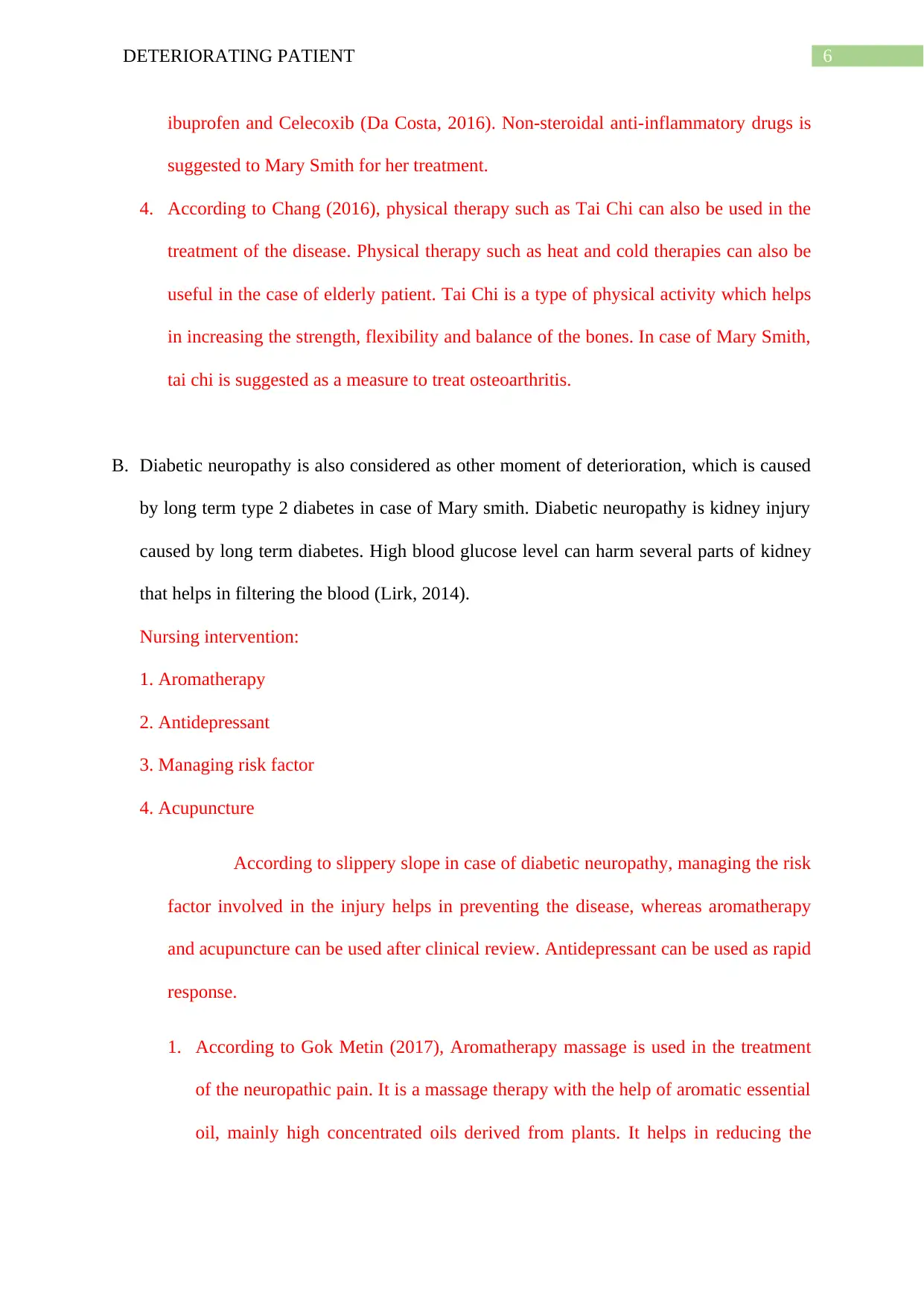
6DETERIORATING PATIENT
ibuprofen and Celecoxib (Da Costa, 2016). Non-steroidal anti-inflammatory drugs is
suggested to Mary Smith for her treatment.
4. According to Chang (2016), physical therapy such as Tai Chi can also be used in the
treatment of the disease. Physical therapy such as heat and cold therapies can also be
useful in the case of elderly patient. Tai Chi is a type of physical activity which helps
in increasing the strength, flexibility and balance of the bones. In case of Mary Smith,
tai chi is suggested as a measure to treat osteoarthritis.
B. Diabetic neuropathy is also considered as other moment of deterioration, which is caused
by long term type 2 diabetes in case of Mary smith. Diabetic neuropathy is kidney injury
caused by long term diabetes. High blood glucose level can harm several parts of kidney
that helps in filtering the blood (Lirk, 2014).
Nursing intervention:
1. Aromatherapy
2. Antidepressant
3. Managing risk factor
4. Acupuncture
According to slippery slope in case of diabetic neuropathy, managing the risk
factor involved in the injury helps in preventing the disease, whereas aromatherapy
and acupuncture can be used after clinical review. Antidepressant can be used as rapid
response.
1. According to Gok Metin (2017), Aromatherapy massage is used in the treatment
of the neuropathic pain. It is a massage therapy with the help of aromatic essential
oil, mainly high concentrated oils derived from plants. It helps in reducing the
ibuprofen and Celecoxib (Da Costa, 2016). Non-steroidal anti-inflammatory drugs is
suggested to Mary Smith for her treatment.
4. According to Chang (2016), physical therapy such as Tai Chi can also be used in the
treatment of the disease. Physical therapy such as heat and cold therapies can also be
useful in the case of elderly patient. Tai Chi is a type of physical activity which helps
in increasing the strength, flexibility and balance of the bones. In case of Mary Smith,
tai chi is suggested as a measure to treat osteoarthritis.
B. Diabetic neuropathy is also considered as other moment of deterioration, which is caused
by long term type 2 diabetes in case of Mary smith. Diabetic neuropathy is kidney injury
caused by long term diabetes. High blood glucose level can harm several parts of kidney
that helps in filtering the blood (Lirk, 2014).
Nursing intervention:
1. Aromatherapy
2. Antidepressant
3. Managing risk factor
4. Acupuncture
According to slippery slope in case of diabetic neuropathy, managing the risk
factor involved in the injury helps in preventing the disease, whereas aromatherapy
and acupuncture can be used after clinical review. Antidepressant can be used as rapid
response.
1. According to Gok Metin (2017), Aromatherapy massage is used in the treatment
of the neuropathic pain. It is a massage therapy with the help of aromatic essential
oil, mainly high concentrated oils derived from plants. It helps in reducing the
Paraphrase This Document
Need a fresh take? Get an instant paraphrase of this document with our AI Paraphraser
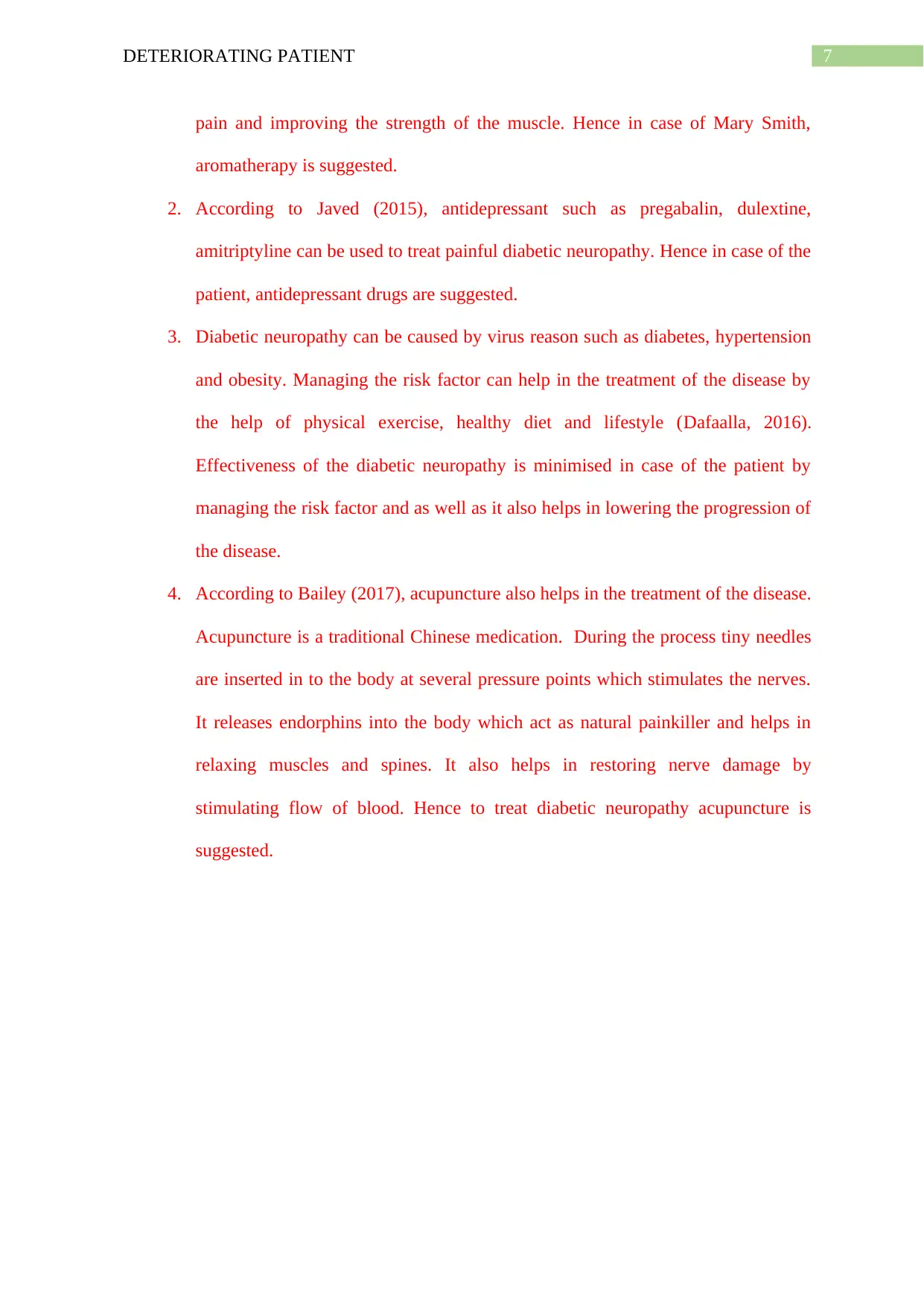
7DETERIORATING PATIENT
pain and improving the strength of the muscle. Hence in case of Mary Smith,
aromatherapy is suggested.
2. According to Javed (2015), antidepressant such as pregabalin, dulextine,
amitriptyline can be used to treat painful diabetic neuropathy. Hence in case of the
patient, antidepressant drugs are suggested.
3. Diabetic neuropathy can be caused by virus reason such as diabetes, hypertension
and obesity. Managing the risk factor can help in the treatment of the disease by
the help of physical exercise, healthy diet and lifestyle (Dafaalla, 2016).
Effectiveness of the diabetic neuropathy is minimised in case of the patient by
managing the risk factor and as well as it also helps in lowering the progression of
the disease.
4. According to Bailey (2017), acupuncture also helps in the treatment of the disease.
Acupuncture is a traditional Chinese medication. During the process tiny needles
are inserted in to the body at several pressure points which stimulates the nerves.
It releases endorphins into the body which act as natural painkiller and helps in
relaxing muscles and spines. It also helps in restoring nerve damage by
stimulating flow of blood. Hence to treat diabetic neuropathy acupuncture is
suggested.
pain and improving the strength of the muscle. Hence in case of Mary Smith,
aromatherapy is suggested.
2. According to Javed (2015), antidepressant such as pregabalin, dulextine,
amitriptyline can be used to treat painful diabetic neuropathy. Hence in case of the
patient, antidepressant drugs are suggested.
3. Diabetic neuropathy can be caused by virus reason such as diabetes, hypertension
and obesity. Managing the risk factor can help in the treatment of the disease by
the help of physical exercise, healthy diet and lifestyle (Dafaalla, 2016).
Effectiveness of the diabetic neuropathy is minimised in case of the patient by
managing the risk factor and as well as it also helps in lowering the progression of
the disease.
4. According to Bailey (2017), acupuncture also helps in the treatment of the disease.
Acupuncture is a traditional Chinese medication. During the process tiny needles
are inserted in to the body at several pressure points which stimulates the nerves.
It releases endorphins into the body which act as natural painkiller and helps in
relaxing muscles and spines. It also helps in restoring nerve damage by
stimulating flow of blood. Hence to treat diabetic neuropathy acupuncture is
suggested.
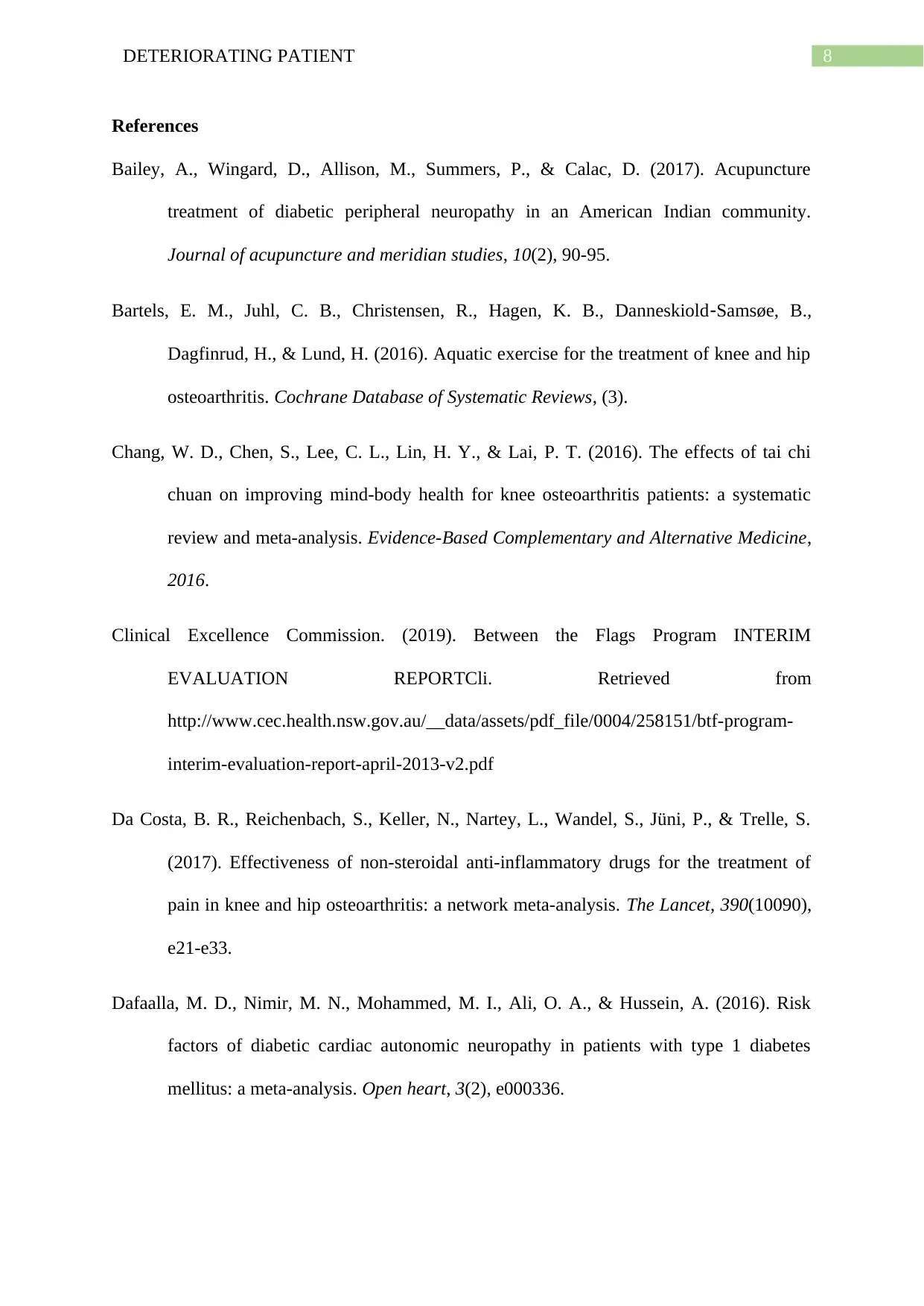
8DETERIORATING PATIENT
References
Bailey, A., Wingard, D., Allison, M., Summers, P., & Calac, D. (2017). Acupuncture
treatment of diabetic peripheral neuropathy in an American Indian community.
Journal of acupuncture and meridian studies, 10(2), 90-95.
Bartels, E. M., Juhl, C. B., Christensen, R., Hagen, K. B., Danneskiold‐Samsøe, B.,
Dagfinrud, H., & Lund, H. (2016). Aquatic exercise for the treatment of knee and hip
osteoarthritis. Cochrane Database of Systematic Reviews, (3).
Chang, W. D., Chen, S., Lee, C. L., Lin, H. Y., & Lai, P. T. (2016). The effects of tai chi
chuan on improving mind-body health for knee osteoarthritis patients: a systematic
review and meta-analysis. Evidence-Based Complementary and Alternative Medicine,
2016.
Clinical Excellence Commission. (2019). Between the Flags Program INTERIM
EVALUATION REPORTCli. Retrieved from
http://www.cec.health.nsw.gov.au/__data/assets/pdf_file/0004/258151/btf-program-
interim-evaluation-report-april-2013-v2.pdf
Da Costa, B. R., Reichenbach, S., Keller, N., Nartey, L., Wandel, S., Jüni, P., & Trelle, S.
(2017). Effectiveness of non-steroidal anti-inflammatory drugs for the treatment of
pain in knee and hip osteoarthritis: a network meta-analysis. The Lancet, 390(10090),
e21-e33.
Dafaalla, M. D., Nimir, M. N., Mohammed, M. I., Ali, O. A., & Hussein, A. (2016). Risk
factors of diabetic cardiac autonomic neuropathy in patients with type 1 diabetes
mellitus: a meta-analysis. Open heart, 3(2), e000336.
References
Bailey, A., Wingard, D., Allison, M., Summers, P., & Calac, D. (2017). Acupuncture
treatment of diabetic peripheral neuropathy in an American Indian community.
Journal of acupuncture and meridian studies, 10(2), 90-95.
Bartels, E. M., Juhl, C. B., Christensen, R., Hagen, K. B., Danneskiold‐Samsøe, B.,
Dagfinrud, H., & Lund, H. (2016). Aquatic exercise for the treatment of knee and hip
osteoarthritis. Cochrane Database of Systematic Reviews, (3).
Chang, W. D., Chen, S., Lee, C. L., Lin, H. Y., & Lai, P. T. (2016). The effects of tai chi
chuan on improving mind-body health for knee osteoarthritis patients: a systematic
review and meta-analysis. Evidence-Based Complementary and Alternative Medicine,
2016.
Clinical Excellence Commission. (2019). Between the Flags Program INTERIM
EVALUATION REPORTCli. Retrieved from
http://www.cec.health.nsw.gov.au/__data/assets/pdf_file/0004/258151/btf-program-
interim-evaluation-report-april-2013-v2.pdf
Da Costa, B. R., Reichenbach, S., Keller, N., Nartey, L., Wandel, S., Jüni, P., & Trelle, S.
(2017). Effectiveness of non-steroidal anti-inflammatory drugs for the treatment of
pain in knee and hip osteoarthritis: a network meta-analysis. The Lancet, 390(10090),
e21-e33.
Dafaalla, M. D., Nimir, M. N., Mohammed, M. I., Ali, O. A., & Hussein, A. (2016). Risk
factors of diabetic cardiac autonomic neuropathy in patients with type 1 diabetes
mellitus: a meta-analysis. Open heart, 3(2), e000336.
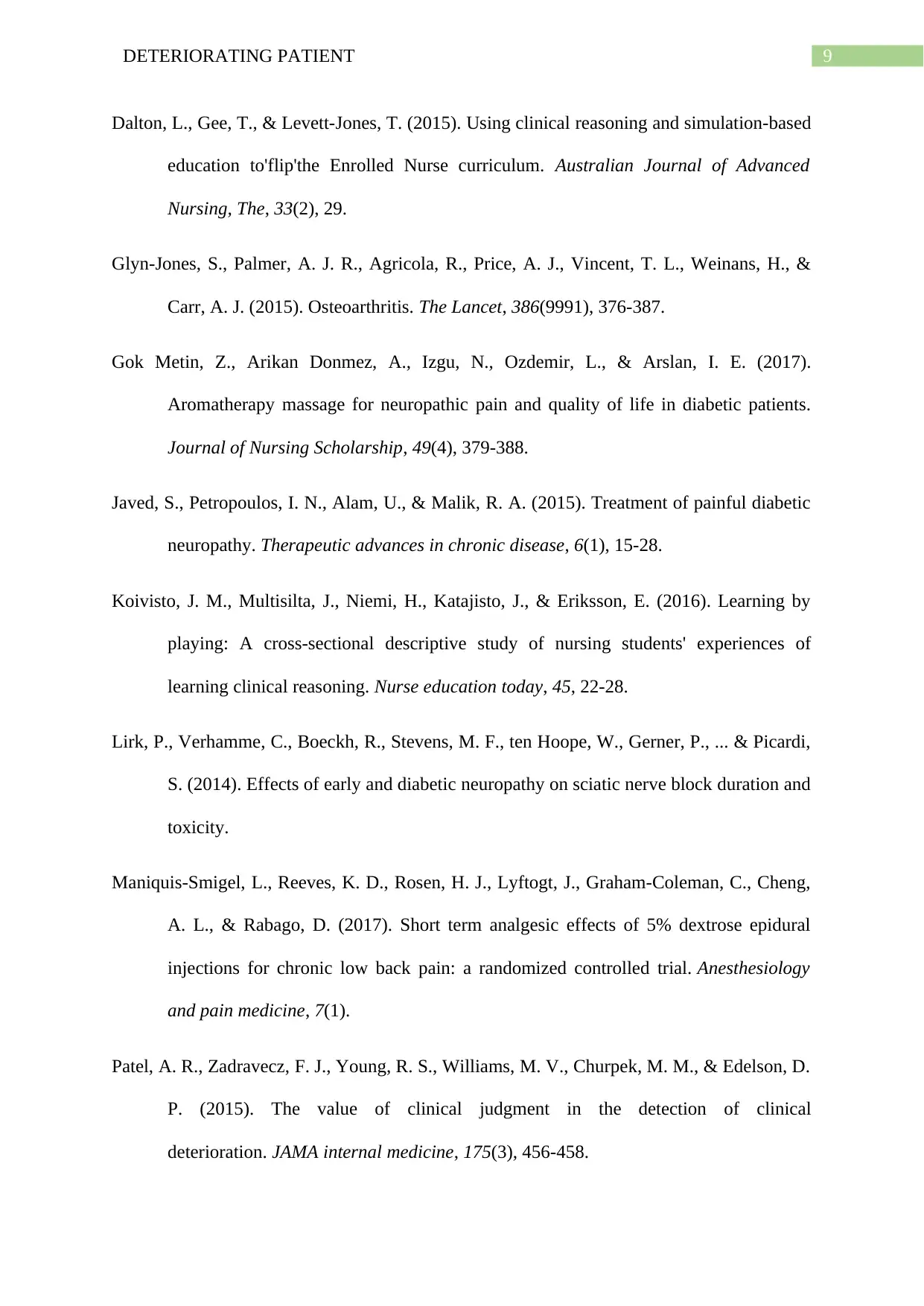
9DETERIORATING PATIENT
Dalton, L., Gee, T., & Levett-Jones, T. (2015). Using clinical reasoning and simulation-based
education to'flip'the Enrolled Nurse curriculum. Australian Journal of Advanced
Nursing, The, 33(2), 29.
Glyn-Jones, S., Palmer, A. J. R., Agricola, R., Price, A. J., Vincent, T. L., Weinans, H., &
Carr, A. J. (2015). Osteoarthritis. The Lancet, 386(9991), 376-387.
Gok Metin, Z., Arikan Donmez, A., Izgu, N., Ozdemir, L., & Arslan, I. E. (2017).
Aromatherapy massage for neuropathic pain and quality of life in diabetic patients.
Journal of Nursing Scholarship, 49(4), 379-388.
Javed, S., Petropoulos, I. N., Alam, U., & Malik, R. A. (2015). Treatment of painful diabetic
neuropathy. Therapeutic advances in chronic disease, 6(1), 15-28.
Koivisto, J. M., Multisilta, J., Niemi, H., Katajisto, J., & Eriksson, E. (2016). Learning by
playing: A cross-sectional descriptive study of nursing students' experiences of
learning clinical reasoning. Nurse education today, 45, 22-28.
Lirk, P., Verhamme, C., Boeckh, R., Stevens, M. F., ten Hoope, W., Gerner, P., ... & Picardi,
S. (2014). Effects of early and diabetic neuropathy on sciatic nerve block duration and
toxicity.
Maniquis-Smigel, L., Reeves, K. D., Rosen, H. J., Lyftogt, J., Graham-Coleman, C., Cheng,
A. L., & Rabago, D. (2017). Short term analgesic effects of 5% dextrose epidural
injections for chronic low back pain: a randomized controlled trial. Anesthesiology
and pain medicine, 7(1).
Patel, A. R., Zadravecz, F. J., Young, R. S., Williams, M. V., Churpek, M. M., & Edelson, D.
P. (2015). The value of clinical judgment in the detection of clinical
deterioration. JAMA internal medicine, 175(3), 456-458.
Dalton, L., Gee, T., & Levett-Jones, T. (2015). Using clinical reasoning and simulation-based
education to'flip'the Enrolled Nurse curriculum. Australian Journal of Advanced
Nursing, The, 33(2), 29.
Glyn-Jones, S., Palmer, A. J. R., Agricola, R., Price, A. J., Vincent, T. L., Weinans, H., &
Carr, A. J. (2015). Osteoarthritis. The Lancet, 386(9991), 376-387.
Gok Metin, Z., Arikan Donmez, A., Izgu, N., Ozdemir, L., & Arslan, I. E. (2017).
Aromatherapy massage for neuropathic pain and quality of life in diabetic patients.
Journal of Nursing Scholarship, 49(4), 379-388.
Javed, S., Petropoulos, I. N., Alam, U., & Malik, R. A. (2015). Treatment of painful diabetic
neuropathy. Therapeutic advances in chronic disease, 6(1), 15-28.
Koivisto, J. M., Multisilta, J., Niemi, H., Katajisto, J., & Eriksson, E. (2016). Learning by
playing: A cross-sectional descriptive study of nursing students' experiences of
learning clinical reasoning. Nurse education today, 45, 22-28.
Lirk, P., Verhamme, C., Boeckh, R., Stevens, M. F., ten Hoope, W., Gerner, P., ... & Picardi,
S. (2014). Effects of early and diabetic neuropathy on sciatic nerve block duration and
toxicity.
Maniquis-Smigel, L., Reeves, K. D., Rosen, H. J., Lyftogt, J., Graham-Coleman, C., Cheng,
A. L., & Rabago, D. (2017). Short term analgesic effects of 5% dextrose epidural
injections for chronic low back pain: a randomized controlled trial. Anesthesiology
and pain medicine, 7(1).
Patel, A. R., Zadravecz, F. J., Young, R. S., Williams, M. V., Churpek, M. M., & Edelson, D.
P. (2015). The value of clinical judgment in the detection of clinical
deterioration. JAMA internal medicine, 175(3), 456-458.
Secure Best Marks with AI Grader
Need help grading? Try our AI Grader for instant feedback on your assignments.
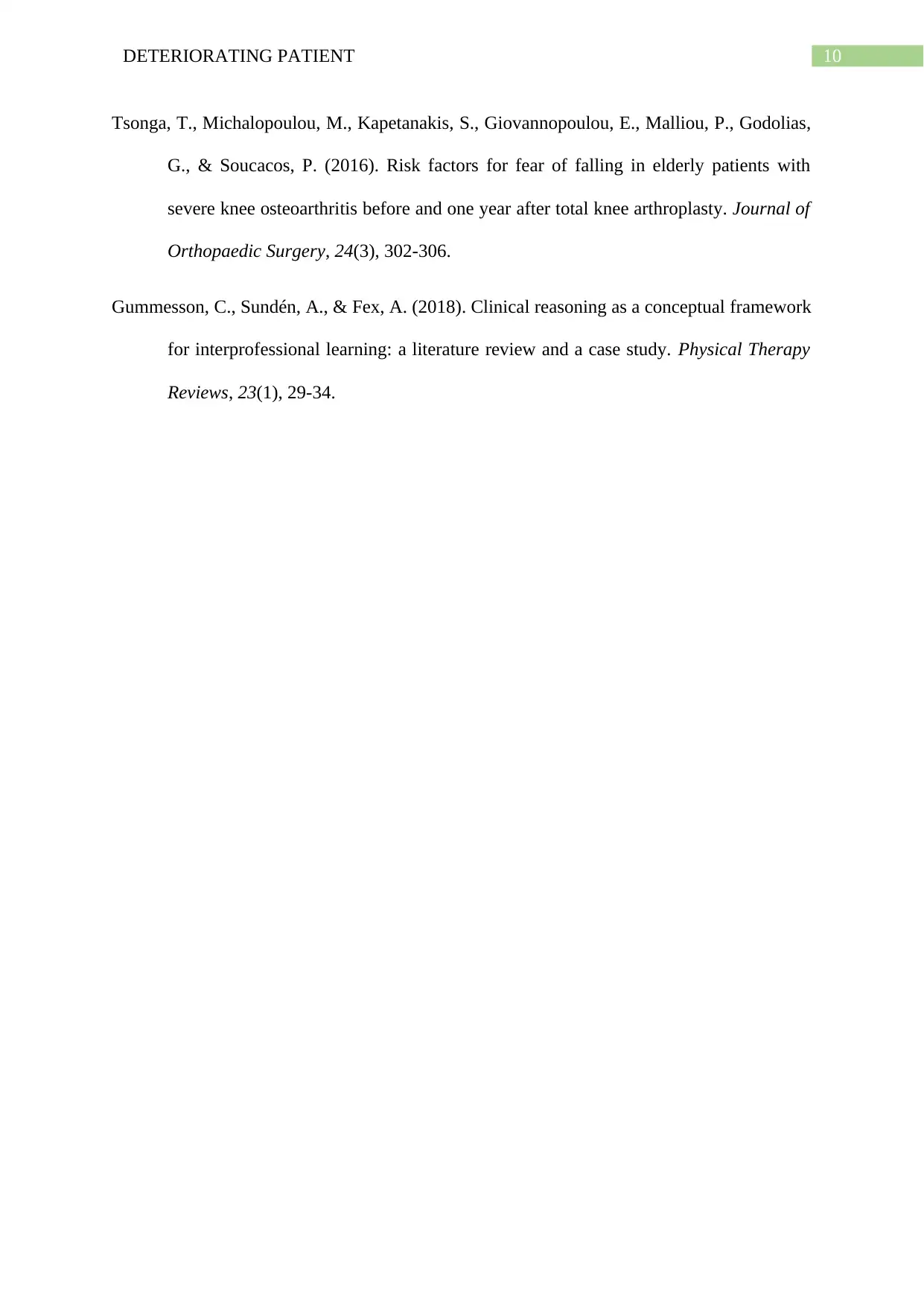
10DETERIORATING PATIENT
Tsonga, T., Michalopoulou, M., Kapetanakis, S., Giovannopoulou, E., Malliou, P., Godolias,
G., & Soucacos, P. (2016). Risk factors for fear of falling in elderly patients with
severe knee osteoarthritis before and one year after total knee arthroplasty. Journal of
Orthopaedic Surgery, 24(3), 302-306.
Gummesson, C., Sundén, A., & Fex, A. (2018). Clinical reasoning as a conceptual framework
for interprofessional learning: a literature review and a case study. Physical Therapy
Reviews, 23(1), 29-34.
Tsonga, T., Michalopoulou, M., Kapetanakis, S., Giovannopoulou, E., Malliou, P., Godolias,
G., & Soucacos, P. (2016). Risk factors for fear of falling in elderly patients with
severe knee osteoarthritis before and one year after total knee arthroplasty. Journal of
Orthopaedic Surgery, 24(3), 302-306.
Gummesson, C., Sundén, A., & Fex, A. (2018). Clinical reasoning as a conceptual framework
for interprofessional learning: a literature review and a case study. Physical Therapy
Reviews, 23(1), 29-34.
1 out of 11
Related Documents
Your All-in-One AI-Powered Toolkit for Academic Success.
+13062052269
info@desklib.com
Available 24*7 on WhatsApp / Email
![[object Object]](/_next/static/media/star-bottom.7253800d.svg)
Unlock your academic potential
© 2024 | Zucol Services PVT LTD | All rights reserved.





